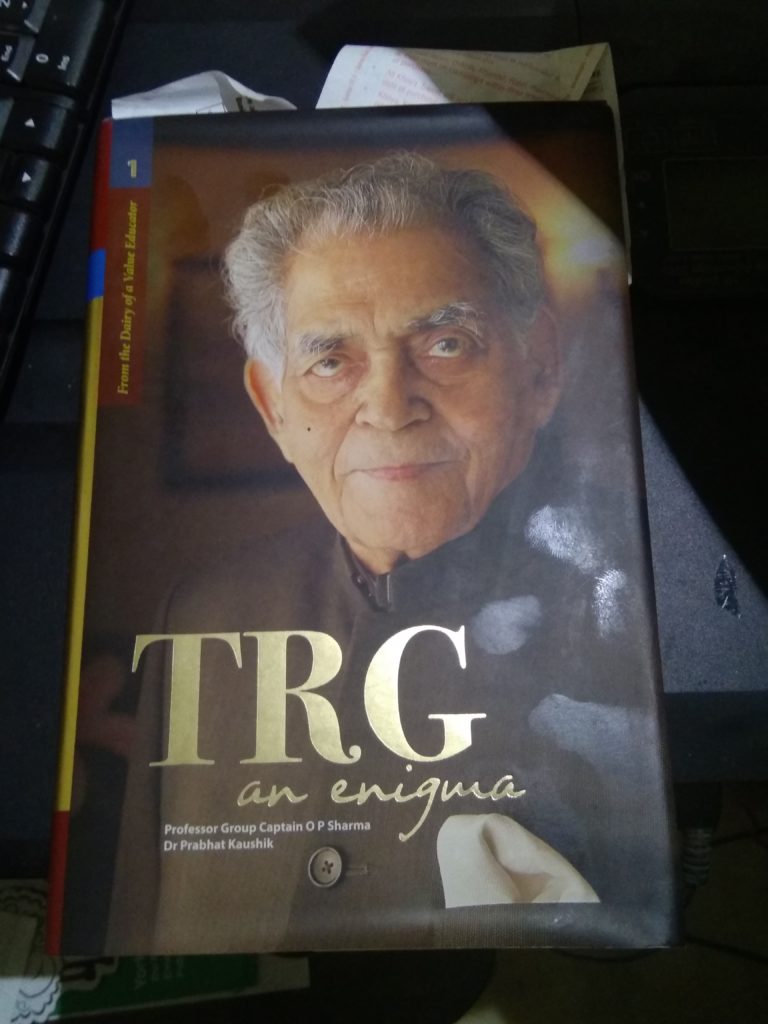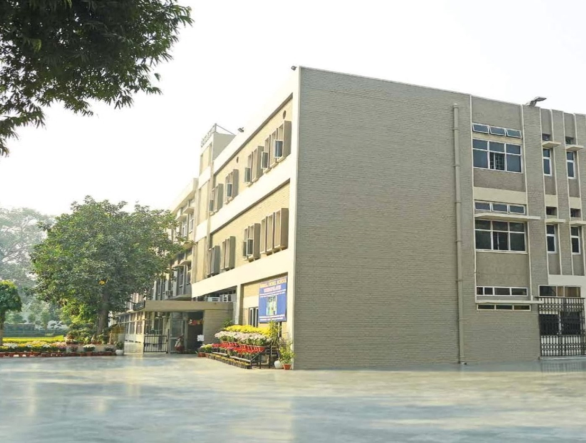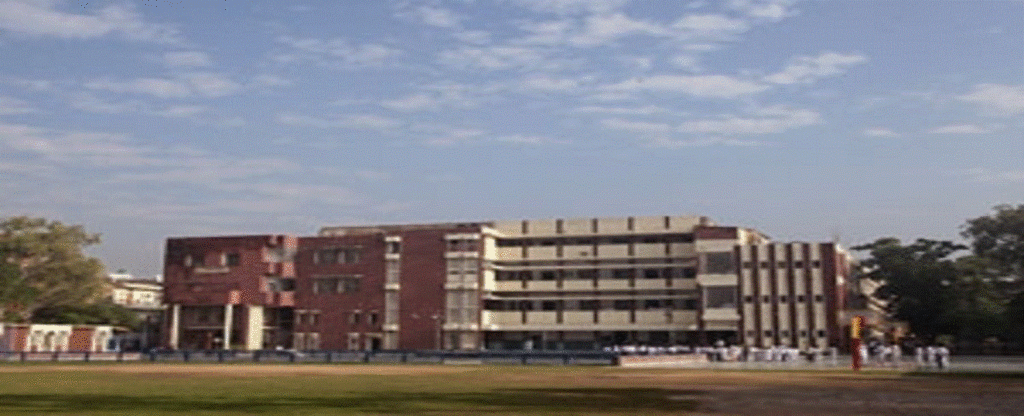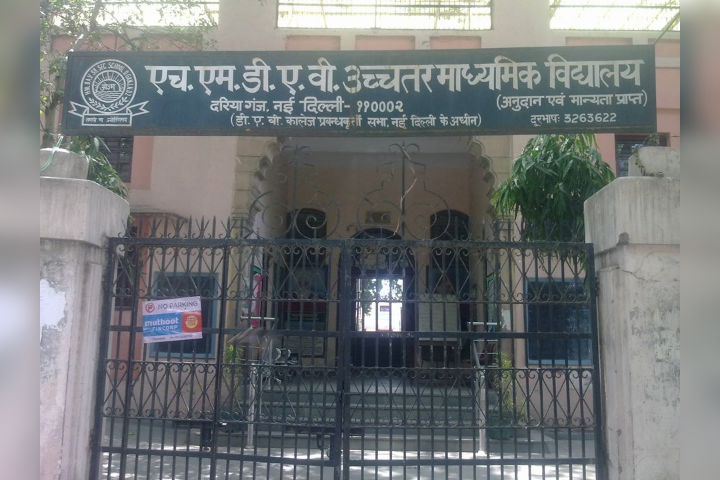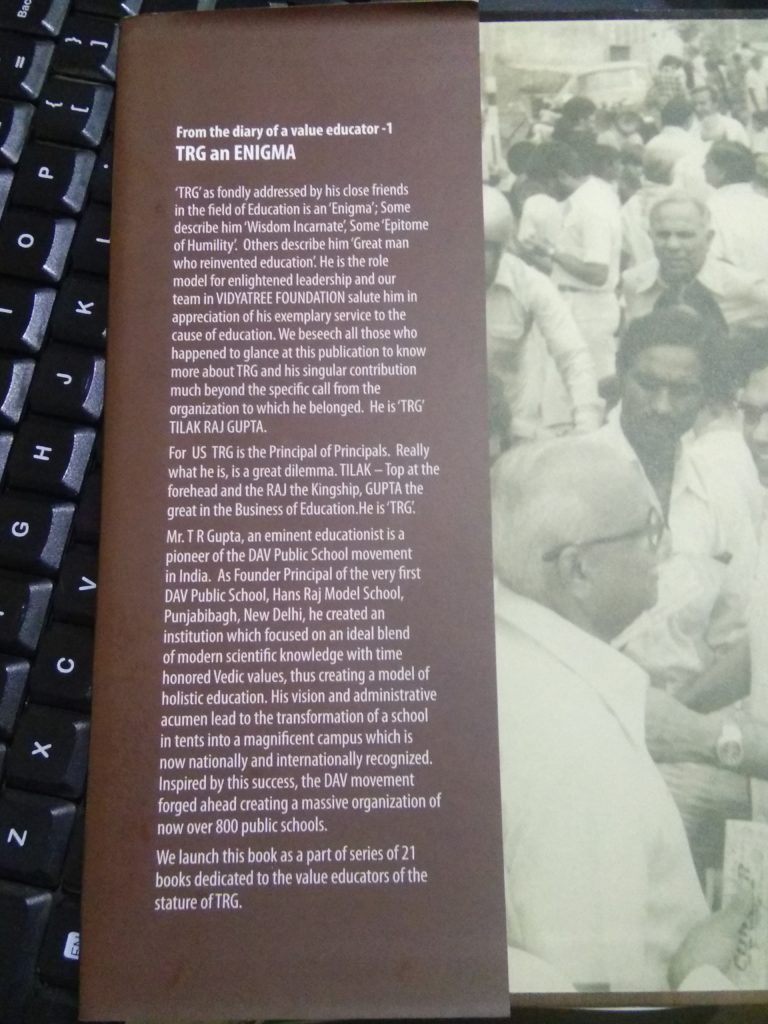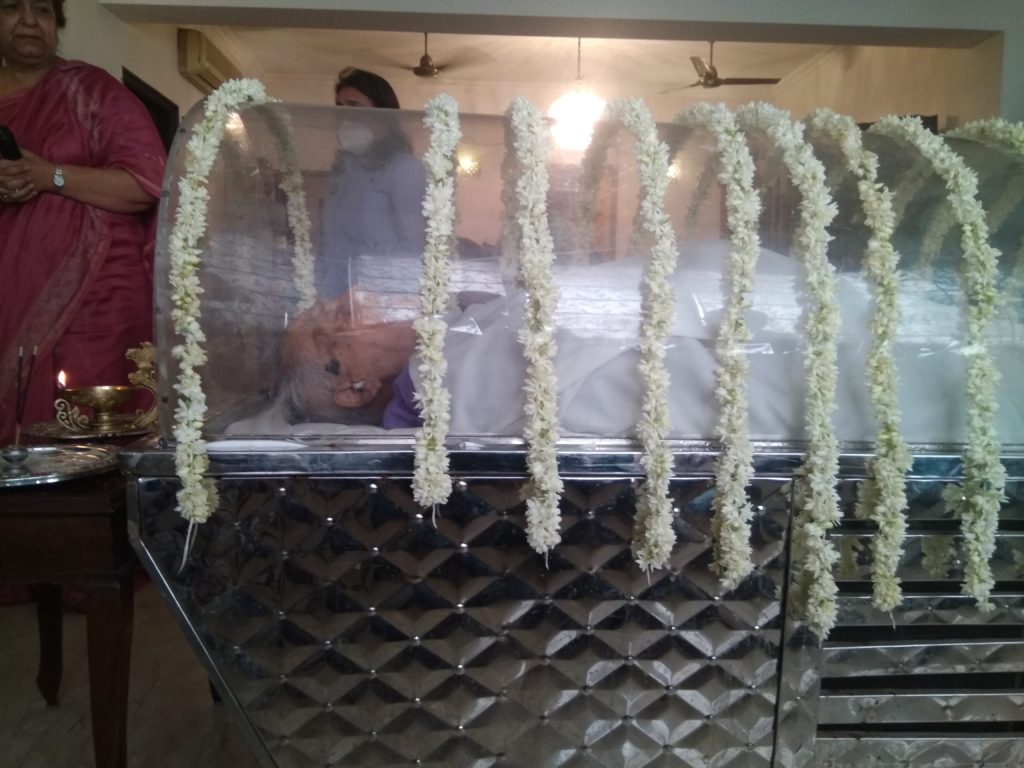
This is the body of Shri. TR Gupta lying in-state for mourners to pay their last respects after his demise on 2nd August, 2022
Principal Shri. TR Gupta, an eminent educationist, passed away at 2:30AM on Tuesday, August 2nd, 2022. Mr. Gupta was the former principal of Hans Raj Model School and Vice President of DAV College Managing Committee. He was also the Chairman of Mahajan Imaging. He served for many years as principal of “Hans Raj Model School”, Punjabi Bagh – which was the first public school under the aegis of DAV Society.
A little more about Principal Shri TR Gupta and His Illustrious Career
1. Public School Movement and Hans Raj Model School, Punjabi Bagh
Today, it is common for every private school – which is not government aided to write “public school” as part of its name. However, in the 1950s and 1960s – there was actually a public school movement – to put in place a vision for public schools, to set standards and also to bring public schools together – so that they could collectively bargain with government to ensure their independence as well as to stand up for the rights of public schools and to put their point of view across.
The “public school movement” was led by Mr.TR Gupta, Mrs. Rajni Kumar – founding principal of Springdales School and also Principals from the Delhi Public School (DPS) group of schools as well as several other visionary school principals of the time. The “public school movement” attempted to set standards for public schools as well as a vision on what constitutes a public school – as well as about the standards a public school should adhere to and the goals and ideals a public school should pursue.
Beyond lending his academic and strategic acumen – Mr. Gupta wrote many articles, position papers as well as spoke extensively about the way public schools should be led as well as the way principals and school administrators should govern and manage teachers, students and more.
His biography observes:
“During the freedom movement the DAV institutions were the vanguard of Indian values. Lala Lajpat Rai was on their management and DAV had students like Shaheed Bhagat Singh who was so deeply influenced by the nationalist ethos of the DAV movement that he embraced martyrdom for the freedom of the nation… DAV ran the institutions without getting any aid from the government. They accepted aid soon after freedom, but this experience was frustrating as the government, in the name of regulating education, controlled them, virtually strangulated them. There was a strong feeling There was a strong feeling in the organization that they should get out of the stifling control of the government. So the need for starting an unaided school was badly felt.
At the same time they found affluent sections of Hindu society rubbing their nose at the doors of the Christian schools. It was felt that an educational education like DAV should be able to provide an alternative to the Christian Schools and preserve and propagate core Indian ethos and culture…. The honour of putting this new concept into action fell upon TR Gupta ad with the blessings of their revered elders, he started the journey with enthusiasm and zeal.”
2. An Outspoken and Idealistic youth – who lived by Arya Samaj ideals
TR Gupta’s father too was an educationist – and Mr. Gupta took to heart since childhood the Arya Samaj ideals of a casteless society and a society in which every person can speak his or her mind.
So, as a young man hard-pressed to support his family, his parents pushed him to go to a Mahajan Sabha and try to connect with others in his community who may help him. During the gathering, there was a point where they said “whoever wants to say something can come forward and speak” and the young TR Gupta came on stage and said something to the effect that as an arya samaji he didn’t believe in caste, nor in community gatherings like Mahajan Sabha but that he was there at his parent’s behest to connect with others in his community who may be able to help him.
Hearing these words the whole gathering went silent – and the young TR Gupta stood on stage wondering what next – since in the 1940s and 1950s it was a given that many of the community elders might have fairly rigid notions about caste and social hierarchy and might not be the ones to listen or even tolerate the enthusiasm of a teenager speaking his mind out. But then suddenly, the Late Lala Mehar Chand Mahajan came forward and complimented him on his forthrightness, clear-headedness and idealism. Lala-ji said he would take him under his wing and a mindset and forthrightness like TR Gupta’s is what is needed in young men to build a bright future for independent India.
Lala Mehar Chand Mahajan, later Chief Justice Mehar Chand Mahajan was a tall figure even in pre-independence India as a brilliant lawyer and as a highly respected citizen active in social and political circles of the time including the DAV society, who was the last Prime Minister of Kashmir – who advised the Maharaja Hari Singh to accede to India and reached out to Nehru on his behalf. Even as the Maharaja vacillated, Lala Mehar Chand Mahajan went around the valley giving speeches and rallying support and trying to bring both Sheikh Abdullah’s supporters as well as Hari Singh’s supporters as well as common citizens of the valley together to rally support for the defence of Kashmir against Pakistani invaders. Lala Mehar Chand Mahajan assured people that Kashmir would not fall to Pakistan and that the invaders would be repelled and even Baramulla and other areas that had fallen to the invaders would be won back – and prevailed upon the king to seek India’s help to save Kashmir from the Pakistani invaders. Later as Chief Justice, he made several landmark judgments.
But life is never a straight line- and while the young TR Gupta, self-respecting and independent in his idealism wanted a job to support and care for his parents – perhaps while pursuing a BA and then becoming an educationist like his father – Lala-ji had other plans and other suggestions. Lala-ji suggested that the young TR Gupta study hard and try to get into the Indian Administrative Service and as an IAS officer contribute to India’s growth and progress. TR Gupta didn’t agree with this, since even while studying for his BA, he was working and he wanted to be able to financially help his parents and ease their financial difficulties. This infuriated Lala Mehar Chand Mahajan and when the young TR Gupta after completing his BA with a third division tried searching for a job, he found himself getting rejected even from jobs he was sure he would get. At some point he realised he may have incurred Lala-ji’s displeasure. So, with a lot of effort and with a certain amount of difficulty, he managed to get an audience with Lala-ji and explained his own predicament to him – as well as his need to earn and financially support his family.
At this point, after once again expressing his belief that he still felt the IAS to be the best way for TR Gupta to serve the nation, Lala-ji assured him that he would not stymie his progress along his chosen path to be an educationist – still felt strongly about the need to men like TR Gupta to join the IAS even though he now understood his reasons too.
Thus started TR Gupta’s career as an educationist that saw him take a number of jobs as a teacher, as a school administrator and as a principal – where his greatest achievements are in the thousands of lives he touched and the organisations and the organisational cultures he nurtured and fostered, during his career as an educationist and beyond that during his stints in various governing bodies including as chairman of Mahajan Imaging.
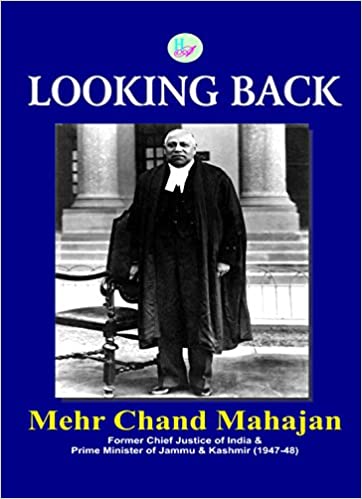
Book: Autobiography of Mehar Chand Mahajan ( Amazon Link: https://amzn.to/3oPwcrO )
3. An Idealistic Activist who even as a teenager wanted to serve society
Beyond serving society and willingly embracing pain and even imprisonment for the sake of his ideals- this is also how TR Gupta first met his future father in-law Ram Chand Mahajan– who saw in him as the man he wanted to give his daughter’s hand in marriage.
Around the time India gained independence, Mr. Gupta was a teenaged RSS activist – since he personally identified deeply with the ideals of serving society and of respect for Indian culture. However, immediately after Mahatma Gandhi’s Assassination, the Congress government of the time, banned RSS, and without trial arrested hundreds or even thousands of RSS members from across the country – and imprisoned them without charges at Himalayan prisoner of war camps built by the British during World War-2 to hold enemy Soldiers. Without charges and without having committed a crime, TR Gupta who was perhaps among the youngest RSS members held – was held for months and months – and every few weeks or months, the prison term for him and his companions was indefinitely extended and while he worried for his parents and his family worried for him, there seemed no hope. But finally he was freed.
Some of his companions feigned insanity to be transferred to mental asylums and then after a period, would be declared fit and free to leave – but steadfast in his ideals, TR Gupta accepted his lot as a political prisoner – and with his head held high, weathered his imprisonment till he was finally released.
During that time, one of the senior prisoners – imprisoned without charges by the Congress government of the time, was Ram Chand Mahajan – who was released much earlier than TR Gupta – but who was so impressed by the young man’s idealism and strength of character that he decided to marry his daughter Pushpa Mahajan to the young TR Gupta.
His biography tells of the problems he faced as he was perhaps the youngest prisoner, and the severe stress and worry about his parents’ well-being – but he did not bow, nor apologise or seek excuses and though he was an innocent teenager being held without charges and for no crime or fault of his – he kept his chin high – and stayed in imprisonment till the Congress government of the day realised the futility of indefinitely holding political prisoners and finally the ban on RSS was lifted and young TR Gupta and his companions were released from indefinite captivity.
Today he is survived by Mrs. Pushpa Mahajan (who’s father Ram Chand Mahajan he first met while in captivity) and their son Dr. Harsh Mahajan (who was awarded the Padma Shri in 2002) and daughter Mrs. Poonam Bewtra (a professor of economics)– and his grandchildren and great-grandchildren.
Though his subsequent career focused on school administration and in guiding and leading the DAV Society as well as in nurturing the “Public School Movement” in India, his biography notes:
“His contact with the RSS in his early youth had generated a patriotic zeal in him. He was lucky to get an opportunity a school free from the government fetters and to fulfil his long cherished desire to create a model actualizing the concept of creating a school with our own invaluable cultural background that could be imbibed through elements of Vedic ideology and a system of education in the modernized context.”
4. A professional administrator – who fought hard to ensure better salaries for his staff
When initially inducted as principal of the school we now know as Hans Raj Model School Punjabi Bagh – the salaries of teachers were low and the school lacked facilities and functioned from a 7-acre piece of land which Dr. GL Datta had bought in name of “DAV College Managing Committee”.
As principal, TR Gupta, who himself had seen his family face financial hardship as a youth, fought long and hard to ensure his teachers get a salary at least at par with government school teachers.
He set aside a plot of land within his school to provide quarters as well as bathing and washing spaces for Class-IV employees – whose dedication he was very impressed by and along with teaching staff he also took special care of the support staff including Class-IV employees.
5. An Indian – who believed in National Integration and Secularism
His biography recounts a time when he was the school manager of a DAV School in Darya Ganj (before he took up role of principal, Hans Raj Model School, Punjabi Bagh):
“Around the time of the 1965 Indo-Pak war, a Muslim pilot of Indian Air Force performed brave deeds highly applauded by the press and the members of school charity club decided to award him Rs.1100 (which was a big sum at the time) – but inspite of their best efforts could not trace the fighter-pilot’s address to send him the money.
It so happened that after some time festivities for Diwali had started and the members of the club decided to celebrate Diwali on non-communal lines. Some 150 Muslim students from schools at Fatehpuri in Delhi were invited to participate at a celebration at school. The cultural program of dances and drama, the patriotic songs, made the spirit of Diwali visible, and the participation of Muslim students added to the joy and gaiety of the occasion. Mir Mushtaq, the then Chief Executive Counsellor, was the chief guest at the function. He was so deeply impressed that he sent a letter to all schools that the example of DAV School Darya Ganj of celebrating national festivals on non-communal lines should be emulated and an effort be made to strengthen national integration. TR Gupta was thus a pioneer in initiating activities at school level that had a direct bearing on not just communal harmony of the society but also of the nation. Principal Lala Ramdas Khosla appreciated these innovative acts and subsequently he was honoured with a state award by the Delhi government on account of this initiative.”
6. A world Traveller who tried to bring the best of the world to India
While travelling the then Soviet Union (USSR), he saw in the Soviet people a hunger for material things – and how a young man who they asked for directions first tried to buy his watch and then his pen, which Mr. TR Gupta gladly gifted to him.
Through his trips to Japan, he saw how Japanese think of the society first rather than in terms of the individual and how they focus on collective greatness rather than individual greatness.
While in the USA he saw how girls and boys intermingle – and without getting to stereotypically Indian constructs about gender – they cooperatively work together and help each other.
Each of the above observations and learnings as well as many other learnings – he brought back to India and used as inspiration for innovative ways of approaching education. The many lessons he learnt during his travels inspired him to think, devise and write about new ways in which un-aided schools, the “public schools” could innovate on education and administration – and take the Indian education system forward with a model that was wholly Indian and preserved the Indian ethos – while amalgamating within itself the best of what the world had to offer.
7. As a family Elder Who tried to transmit his ideals to his grandchildren
In his biography one of his grandsons recounts how while studying at IIT Delhi, he wanted to keep long hair but was unsure – and so his grandson decided to consult TR Gupta.
TR Gupta explained to his grandson that if long hair were what he desired- then long hair for him was a means to express his personality. And so he must express his personality by growing his hair long.
In this writer’s understanding, he explained to his grandson that no matter how long he kept his hair long and no matter what he faced as a consequence- by keeping his hair long, his grandson would have a chance to express a part of his personality; almost like saying one’s mind versus keeping quiet and wondering about how it might have been.
And to this writer, this is also the essence of what Maharishi Dayanand writes in Satyarth Prakash about the arya samaji ideals of a society where people are not discriminated on basis of caste or gender nor are they discriminated on the basis of income or social status.
In this context, Maharishi Dayanand, the founder of the Arya Samaj movement wrote: “The most musical instrument with the most beautiful sound is the human voice.” And “all human beings are created equal and reject all barriers of caste and high/low, rich/poor”.
The simple act of explaining to his grandson about how his choice of long or short hair is a form of self expression and a matter of giving voice to his preferences and encouraging his grandson to make choices as per his tastes – gives us all a message about the need to choose and of the need to accept and live comfortably with one’s choices.
And that to my mind is the essence of a lot of what Mr. TR Gupta stood for, and did as his life’s work in academia and in managing and leading.
In Conclusion:
As an after-thought this writer remembers a time some years ago when he visited a Mahajan Imaging centre with a female family member – and was invited by one of the staff members to join in a lunch they had organised to commemorate Dr. Harsh Mahajan’s birthday – and the writer was pleasantly surprised to see doctors of all ages and levels of seniority and technicians and even the support staff eating side by side – the same food in similar plates and in the same part of Mahajan Imaging where a makeshift lunch buffet had been organised.
At the time, this writer hadn’t read Mr. TR Gupta’s biography. And at the time I didn’t know that Mr. TR Gupta was also the chairman of Mahajan imaging.
But when one looks back, it all adds up – and one prays that Mr. TR Gupta’s soul rests in peace.
But just as fervently, one also prays that all those whose lives Mr. Gupta touched: his family, his staff members and the people in the organisations who’s governance Mr.Gupta oversaw and all those who know something of his life and his life’s work:
“I pray that by God’s grace all of them, through their life and through their choices and through their actions all continue to keep the ideals, the values and the passions Mr. Gupta embodied in his lifetime!”
By Nalin Savara ( Twitter: @naldotsav & @gizmodude ; http://www.linkedin.com/in/nsnsns )
References:
- TRG – An Enigma – A Biography of Shri. TR Gupta
- Personal Memories and interactions with family members including Shri. TR Gupta himself.
- Wikipedia Article on Dr.Harsh Mahajan: https://en.wikipedia.org/wiki/Harsh_Mahajan_(radiologist)
- Wikipedia Article on Hans Raj Model School, Punjabi Bagh: https://en.wikipedia.org/wiki/Hans_Raj_Model_School
- Photo Credit: Nalin Savara (The Author)
- HM DAV School Article on Careers360: https://school.careers360.com/schools/hm-dav-senior-secondary-school-daryaganj-delhi
- Hans Raj Model School Punjabi Bagh – School Website: http://hansrajmodelschool.org/
- Wikipedia Page on Late Chief Justice Mehar Chand Mahajan https://en.wikipedia.org/wiki/Mehr_Chand_Mahajan
- Autobiography of Late Chief Justice Mehar Chand Mahajan: https://amzn.to/3oPwcrO

